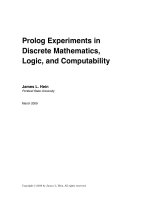Top down si nanowire technology in discrete charge storage nonvolatile memory application
Bạn đang xem bản rút gọn của tài liệu. Xem và tải ngay bản đầy đủ của tài liệu tại đây (1.71 MB, 124 trang )
TOP-DOWN SI NANOWIRE TECHNOLOGY IN
DISCRETE CHARGE STORAGE NONVOLATILE
MEMORY APPLICATION
FU JIA
(B. Eng., Xi’an Jiaotong University)
A THESIS SUBMITTED FOR THE DEGREE OF
DOCTOR OF PHILOSOPHY
DEPARTMENT OF ELECTRICAL & COMPUTER ENGINEERING
NATIONAL UNIVERSITY OF SINGAPORE
2009
I
Acknowledgements
I have been very fortunate to be a member of an active and open research lab
in the National University of Singapore (NUS) and the Institute of Microelectronics
(IME), a reputable A*STAR research institute. Prof. Zhu Chun Xiang, my main
supervisor in the Silicon Nano Device Laboratory, NUS, is the most important person
to my research work. I would like to thank him for bringing me into this colorful
research world and also giving me many opportunities and freedom to pursue my
interests. I would also like to thank Dr. Yu Ming Bin, my co-supervisor in IME, for
his guidance and assistance that allowed me to adapt to a new working environment
quickly. My sincere gratitude goes to Dr. Navab Singh and Dr. Lo Guo Qiang, who
played a significant role in my research work in IME and gave me inspirations for
many ideas. All of them are great mentors who have provided me with their patient
guidance.
PhD life has been an enjoyable journey. I will always remember the
interesting and precious memories I had of lectures by inspiring lecturers Prof. Cho
Byung Jin, Prof. Ganesh Samudra, Prof. Yoo Wong Jong, Prof. Lee Sung Joo and my
own professor in my initial two years in NUS. I also had a joyful time collaborating
with my lab fellows. I would like to thank my seniors and colleagues in Prof. Zhu’s
group, such as Dr. Yu Xiongfei, Dr. Wu Nan, Dr. Zhang Qingchun, Dr. Huang Jidong,
Dr. Song Yan, Chunfu, Jianjun and Ruilong for their guidance and encouragement. I
would also like to express my gratitude to all my SNDL friends, such as Dr Ren Chi,
Dr. Wang Yingqian, Dr. Gao Fei, Dr. Wang Xinpeng, Dr. Tan Kian Ming, Dr. Shen
Chen, Chen Jingde, Pu Jing, Jiang Yu, Zhang Lu, Zhao Hui, Zang Hui, He Wei, Yang
II
Weifeng, Peng Jianwei, Wang Jian and Lee Wayne Yong, for their guidance and close
friendship which I will always treasure. I would like to take this opportunity to thank
the technical staffs in SNDL and IME for their great support and assistance in my
PhD study.
My deepest gratitude goes to my dear parents. Your strong confidence towards
me could drive any scares away from me over these years. My special thanks here go
to you, Mr. Loh Guo Pei. Your knowing love makes me feel that I could never be
lonely in any difficult circumstance.
III
Table of Contents
Acknowledgements
I
Table of Contents
III
Summary
VI
List of Tables
VIII
List of Figures
IX
List of Symbols
XV
List of Abbreviations
XVII
Chapter 1 Introduction
1.1 Introduction of Semiconductor Memory Technology 1
1.1.1 Semiconductor Memory Categories 1
1.1.2 Structure and Operation Mechanism of Flash Memory 5
1.1.3 Challenges of Semiconductor Flash Memory Scaling 9
1.2 Scope of Project 15
1.3 Organization of Thesis 16
Reference 18
Chapter 2
Literature Review
2.1 Introduction 21
2.2 Gate Stack Engineering 21
2.2.1 Nanocrystal Memory 21
IV
2.2.2 Bandgap Engineering Memory 23
2.2.3 High-κ-based MONOS Memory 24
2.3 Novel Structure Nonvolatile Memory Devices 26
2.4 Si Nanowire Technology 29
2.4.1 Bottom-up Approach 29
2.4.2 Top-down Approach 30
Reference 33
Chapter 3 Gate-All-Around Si Nanowire SONOS Memory
3.1 Introduction 40
3.2 Nanowire and Nanowire Memory Device Fabrication 42
3.3 Results and Discussion 48
3.4 Conclusion 58
Reference 59
Chapter 4 GAA Nanowire for TFT SONOS Multi-Level-
Cell Memory Application
4.1 Introduction 62
4.2 Poly-Si Nanowire TFT Memory Device Fabrication 65
4.3 Results and Discussion 67
4.4 Conclusion 76
Reference 78
Chapter 5 GAA Nanowire MONOS for High Speed
Memory Application
5.1 Introduction 82
5.2 TAHOS Nanowire Memory Device Fabrication 84
V
5.3 Results and Discussion 87
5.4 Conclusion 95
Chapter 6 Conclusions
100
List of Publications
100
VI
Summary
The commercial flash memory, which currently uses a polysilicon floating
gate as the charge storage material, has faced issues of non-scalability of the tunnel
oxide and interpoly dielectric in the course of scaling, due to the significantly reduced
coupling ratio and serious gate interference. Due to scaling limitations of the
conventional floating-gate nonvolatile flash memory cells, another type of nonvolatile
memory based on discrete charge trapping is currently being considered as a
promising alternative. The discrete charge storage nonvolatile memories are immune
to local defect related leakage due to isolated charge storage nodes, providing larger
scaling capability than floating gate devices.
This thesis proposes methodologies to resolve issues of gate stack scaling and
voltage scaling in the SONOS type discrete charge storage nonvolatile memory in
order to increase the possibility of it being employed in future semiconductor
nonvolatile memory application. This thesis discusses solutions to scale the discrete
trapped charge-storage nonvolatile memory based on a state-of-the-art non-traditional
structure – a gate-all-around nanowire channel structure – whose fabrication method
completely follows the CMOS-compatible rule in order to increase industrial
adaptability of this novel technology.
A high-speed SONOS nonvolatile memory cell with a gate-all-around (GAA)
Si-nanowire architecture is discussed in detail. The method of fabricating vertically
stacked top-down nanowires with 5-nm diameter is highlighted. The nanowire
SONOS device exhibits evident improvements in low voltage programming and fast
programming and erasing speeds with regards to the planar control device. The
VII
performance enhancement mechanism shall be explained by device modeling which
investigates electron energy distribution, potential energy profile and electric field
along each layer surrounding the nanowire channel. The gate-all-around nanowire
channel structure is introduced into the poly-Si memory as a promising methodology
to resolve issues of poor device subthreshold performance, low memory speed and
inferior device uniformity in low temperature polycrystalline Si TFT memory devices,
which can be integrated in future system-on-panel and system-on-chip applications. A
strategy of optimizing SONOS-type memory characteristics is illustrated and
discussed by integrating high-κ dielectric materials and metal gate electrode. The
application of high-κ materials and TaN metal gate electrode, used to replace the
conventional material used in nitride-based SONOS devices, exhibits improvement of
memory erasing characteristics and causes of the performance enhancement will be
investigated.
This thesis discusses several strategies to overcome challenges that SONOS-
type discrete charge storage nonvolatile memory currently faces. In conclusion, novel
device structures, in addition to new materials such as high-κ dielectrics and high
work function metal gates, are promising candidates that can potentially be integrated
into memory devices. Devices with the nanowire channel structure show promise for
future nonvolatile applications due to their improved performance.
VIII
List of Tables
Table 1.1
Flash Nonvolatile memory technology requirements p.14
Table 4.1
Comparison of memory characteristics with reported TFT
SONOS-type memory devices. The GAA nanowire TFT
memory in this work displays the advantages in both
electrostatic and transient characteristics.
p.76
IX
List of Figures
Fig. 1.1
Revenues of semiconductor memory market versus year. p.1
Fig. 1.2
Semiconductor memory family tree p.2
Fig. 1.3
A schematic cross-section of a single floating-gate transistor. FG
is surrounded by dielectric layers and isolated from channel and
IPD. Taking the n-type memory cell as an example, electrons are
injected from substrate by applying a positive voltage stress at
the gate. Electrons will be trapped in the FG even after the
power is removed from the gate.
p.6
Fig. 1.4
Si and SiO
2
energy band diagram system (a) without applying
any voltage and (b) with applying a positive voltage at SiO
2
side. Electrons are able to tunnel through the thick SiO
2
layer by
F-N tunneling due to a strong electric field reduces the barrier
width. Conduction and valence band offset (∆E
c
and ∆E
v
) keeps
unchanged during the process.
p.8
Fig. 1.5
(a) At CHE stress condition, electrons gain enough energy while
drifting across the channel and are injected through the tunnel
oxide, causing a gate current. (b) Energy band diagram of a
floating-gate memory cell during programming by hot-carrier
injection.
p.9
Fig. 1.6
Comparison of NOR and NAND flash architectures (a) NOR-
type with shared bit line and source line. (b) NAND-type with a
common bit line and a common source line, showing concise
structure advantage.
p.10
Fig. 1.7
Schematic cross section of a floating-gate cell in a (a) word line
direction and (b) bit line direction. (a) Space between
neighboring FG becomes too narrow to be filled with two IPD
layers and control gate poly-Si. (b) V
th
of an unselected cell can
be programmed mistakenly due to the capacitance interference
p.12
X
of the adjacent charge.
Fig. 2.1
The band diagram of BE-SONOS under different electric fields,
showing only the tunnel oxide part. (a) At retention mode, direct
tunneling is prohibited since the barrier width carriers
experience is the whole physical thickness of ONO layer. (b) At
program/erase mode or under high electric field, carriers could
only see the thickness of a thin layer of oxide; hence the speed
can be significantly enhanced due to reduced barrier width.
p.24
Fig. 2.2
Schematic band diagram for the memory device using nitride
(dashed line) and high-k (solid line) as charge trapping layer
under electric field at the perform mode (a) and erase mode (b).
The electric field across the blocking oxide is released and
transferred to tunnel oxide, hence the carriers tunneling
efficiency is improved compared with ONO device.
p.25
Fig. 2.3
Progression of device structure from a single-gated planer on
SOI to a fully GAA nanowire channel, with the number of gates
increasing. (a) Single-gate structure. (b) Double gate structure,
with a tall fin and two symmetrical gates electrically
interconnected. (c) Tri-gate or FinFET structure, where gate
electrode controls the channel on three surfaces. (d) Gate-all-
around structure with a nanowire channel.
p.28
Fig. 2.4
Progress flow of the damascene-gate nanowire device
fabrication used by Samsung’s group (1) SiGe / Si growth and
shallow trench isolation (STI) (2) hard mask SiN trimming (3)
oxide fill in STI and CMP (4) damascene gate stack deposition
(5-6) 1st and 2nd damascene gate etch (7) field oxide recess (8)
SiGe removal and H
2
anneal and (9) gate oxide and gate
material deposition.
p.31
Fig. 3.1
Schematic of the Si fin fabrication process. Starting wafer
consisting of 120-nm Si layer (a) has undergone lithography (b)
and the DRIE process (c) to achieve the Si fin. The smallest
defined fin width is 40-nm after the resist trimming process, and
the DRIE with the well-anisotropic property enables the good
quality fin etch.
p.43
Fig. 3.2
(a) Sample prepared before the oxidation process is finished,
TEM image shows the phenomenon where two nanowires are
formed if the Si fin has a high aspect ratio. (b) Tilted SEM
image shows the two vertically staked Si nanowire channels
connecting S/D pads.
p.45
XI
Fig. 3.3
Schematics of the Si nanowire fabrication process. The Si
nanowire is fabricated using self-limiting oxidation at a
temperature below 950°C. A high aspect ratio of the fin ensures
there will be two vertically stacked nanowires. The vertically
stacked nanowires have the advantage of space saving as
compared to laterally stacked nanowires.
p.45
Fig. 3.4
Process flow depicting the formation of vertically stacked twin
Si nanowire and GAA Si nanowire nonvolatile memory device.
p.46
Fig. 3.5
(a) The titled SEM image of actual device taken before the
passivation SiO
2
was deposited. (b)Vertically stacked two Si
nanowire (VST-SiNW as indicated) channels were surrounded
by ONO and poly-Si gate electrode.
p.47
Fig. 3.6
The high resolution TEM picture shows the cross section part of
one of the two nanowire channels of a fully processed nanowire
SONOS device. The Si nanowire with surrounding ONO layers
followed by poly-Si gate could be seen clearly. Diameter of wire
is about 5-nm and the thickness of each layer of ONO gate stack
is 4.5-nm/4.5-nm/8-nm.
p.48
Fig. 3.7
The transfer characteristics of GAA nanowire memory devices
with nanowire diameter of 5-nm and gate length of 850-nm
shows good electrostatic behavior.
p.49
Fig. 3.8
Transient memory characteristics of nanowire SONOS (NW)
device and planar (PLN) control device at ± 11 V pulse stresses.
Devices with a gate length of L
G
850-nm are used for
characterization. Channel widths are 5-nm for NW device
(diameter) and 5-µm for PLN device respectively.
p.50
Fig. 3.9
Simulated (a) electric field distribution and (b) potential energy
profile of GAA nanowire and planar structures at gate stress 11
V. For the GAA device (solid line), the electric field at the Si-
SiO
2
interface is almost three times larger as compared to the
planar device (dashed line). The effective barrier width of the
GAA nanowire device is also less than half the oxide physical
thickness. (c) Potential energy profile at V
GS
= –11 V prior to the
start of the erasing process for the GAA nanowire device. An
electron concentration of 5.3x10
7
cm
-1
, corresponding to a shift
of 2.6V in V
th
, is assumed in the nitride layer. The barrier width
for holes tunneling from the channel to the oxide is reduced due
to the cylindrical architecture, thus increasing the erase speed.
p.52
XII
Fig. 3.10
(a) Programming and (b) erasing characteristics of Si nanowire
SONOS cell (NW diameter ~ 8-nm) of gate length of 850-nm.
Based on the programming characteristics, this device exhibits a
V
th
shift of 1.13 V in 1 µs using a pulse of +11 V on the gate.
p.54
Fig. 3.11
(a) Programming and (b) erasing characteristics of Si nanowire
SONOS cell (NW diameter ~ 5-nm) of gate length of 850-nm.
Based on the programming characteristics, this device exhibits a
V
th
shift of 2.61 V in 1 µs using a pulse of +11 V on the gate.
p.55
Fig. 3.12
Room-temperature data retention properties for nanowire
devices. The stored charge could be kept well for the measured
10
4
seconds.
p.57
Fig. 3.13
Endurance characteristics of the Si nanowire SONOS device. p.57
Fig. 4.1
A tilted SEM image of isolated nanowire channel with source
and drain pads located on SiO
2
after the nanowire was released
in DHF. It can be seen that the amorphous Si has converted to
poly-Si after the steam oxidation step.
p.66
Fig. 4.2
TEM cross-section through the poly-Si nanowire of a fabricated
device. The cross-section was cut across the nanowire channel.
The nanowire channel width and height are 23-nm and 36-nm
respectively as shown by the arrows.
p.66
Fig. 4.3
Transfer characteristics of nanowire TFT SONOS device with
23-nm width and 350-nm gate length. Improved SS is exhibited
as compared to other reported TFT SONOS memory devices.
p.67
Fig. 4.4
The dependence of SS on poly-Si nanowire width. It can be seen
that the device with smaller wire width achieves better SS,
which is due to reduced gate controllability and increased
volume of grain boundaries in the wider nanowire channel.
p.68
Fig. 4.5
The P/E characteristics of nanowire TFT SONOS with wire
width 23-nm. The gate pulse stress ranged from 11 V to 15 V
and -12 V to -18 V. ∆V
th
of 2.96 V could be achieved in 1 µs at
15 V gate pulse during program.
p.71
Fig. 4.6
Comparison of memory window among devices with three
different nanowire widths under different stress voltage for a
program time of 1 µs. The device with the narrowest wire width
p.72
XIII
shows the fastest speed.
Fig. 4.7
The band diagram during program in devices with smaller wire
width (left) and larger wire width (right). Stressed at the same
voltage, the electric field across the tunnel oxide of the device
with smaller wire width is enhanced as compared to that of the
counterpart, due to the particular GAA structure.
p.73
Fig. 4.8
The I
d
-V
g
at four states shows the feasibility of the MLC
application for TFT SONOS. Around 1.5-V memory window is
set between the different states.
p.74
Fig. 4.9
The room temperature retention properties measured at different
data states. The most severe degradation is 12% charge loss after
10 years.
p.75
Fig. 5.1
The schematics of the main process steps along with the process
fabrication flow for fabricating the GAA nanowire TAHOS
memory cell.
p.85
Fig. 5.2
A tilted SEM image of the nanowire with source and drain pads
located on BOX after the nanowire was released in DHF.
p.85
Fig. 5.3
TEM image showing the cross-section of fabricated GAA
nanowire TAHOS device. The nanowire can be observed to be
surrounded by TaN metal gate and high-κ oxide. Empty spaces
are attributed to high stress formed at the interface TaN layer.
p.87
Fig. 5.4
The I
d
-V
g
curve measured from the nanowire TAHOS device
shows good subthreshold and electrostatic property, despite a
thick EOT used in memory.
p.88
Fig. 5.5
Transient memory characteristics of the nanowire TAHOS (NW-
TAHOS) device as well as the nanowire SONOS (NW-SONOS)
control device at the onset of the P/E. The TAHOS device shows
equivalent program and erase speed while the SONOS device
does not.
p.89
Fig. 5.6
Program and erase characteristics of nanowire TAHOS memory
(TAHOS-NW in the figure). Large memory window and
especially enhanced erase speed can be seen.
p.91
XIV
Fig. 5.7
Program and erase characteristics of nanowire SONOS memory
device (SONOS-NW in the figure). The erasing speed is much
less than the programming speed which greatly retards the
cycling of SONOS.
p.91
Fig. 5.8
Band diagram of nanowire TAHOS (solid line) and nanowire
SONOS (dash line).
p.93
Fig. 5.9
P/E endurance of nanowire TAHOS device at two cycling
conditions. The larger memory window with 2.67 V magnitude
was achieved when the device was under ±11V stress voltage
cycling conditions with a slight upward shift.
p.94
Fig. 5.10
Room temperature data retention of the nanowire TAHOS
device. The same magnitude of memory window can be
achieved by a smaller P/E voltage as compared to its
counterpart, despite slightly larger charge loss at the same
measurement time period.
p.95
XV
List of Symbols
C capacitance (F)
d thickness
d
nw
diameter of nanowire
E electrical field (V/cm)
E
g
band gap (eV)
E
inj
electric field at the injecting surface
h Planck’s constant (6.626×10
-34
Js)
I current (A)
I
d
drain current (A)
I
g
gate leakage current (A)
J current density (A/cm2)
L channel length (µm)
m
*
effective mass (kg)
Q charge (C)
T
Q
charges stored in the gate insulator at a distance
I
d
from the gate (C)
T temperature (°C)
t time (sec)
t
ox
thickness of oxide
V voltage (V)
V
cg
control gate potential (V)
V
d
drain voltage (V)
V
g
gate voltage (V)
V
fb
flatband voltage (V)
XVI
V
th
threshold voltage (V)
Ф
b
barrier height (eV)
Ф
M
work function of metal (eV)
κ
Si3N4
dielectric constant of Si
3
N
4
(relative permittivity)
κ
SiO2
dielectric constant of SiO
2
(relative permittivity)
∆E
c
conduction band offset (eV)
∆E
v
valence band offset (eV)
∆V
th
threshold voltage shift (V)
XVII
List of Abbreviations
ALD Atomic layer Deposition
BBHH Band-To-Band Tunneling Hot Hole Injection
BOX Buried Oxide
CG Control Gate
CHE Channel Hot Electron
CVD Chemical Vapor Deposition
DIBL Drain-Induced-Barrier-Lowing
DG Double Gate
DRAM Dynamic Random Access Memory
DRIE Deep Reactive Ion Etching
DT Direct Tunneling
EEPROM Electrically Erasable and Programmable Read Only Memory
EOT Equivalent Oxide Thickness
EPROM Electrically Programmable Read Only Memory
FG Floating Gate
F-N Fowler-Nordheim
GAA Gate-All-Around
HRTEM High Resolution Transmission Electron Microscopy
IPD Interpoly Dielectric
ITRS International Technology Roadmap for Semiconductors
LPCVD Low Pressure Chemical Vapor Deposition
MONOS Metal/ Oxide / Nitride / Oxide / Silicon
XVIII
NC Nanocrystal
NVM Nonvolatile Memory
PDA Post Deposition Anneal
PECVD Plasma-Enhanced Chemical Vapor Deposition
Poly-Si Polycrystalline Silicon
PVD Physical Vapor Deposition
RAM Random Access Memory
ROM Read Only Memories
S/D Source and Drain
SCE Short Channel Effect
SEM Scanning Electron Microscopy
SIMS Secondary Ion Mass Spectroscopy
SOI Silicon-On-Insulator
SONOS Si / SiO
2
/ Si
3
N
4
/ SiO
2
/ Si
STI Shallow Trench Isolation
SRAM Static Random Access Memory
SS Subthreshold Swing
TAHOS TaN / Al
2
O
3
/ HfO
2
/ SiO
2
/ Si
TEOS Tetraethyl Orthosilicate
TEM Transmission Electron Microscopy
UTB Ultra-Thin Body
VLS Vapor-Liquid-Solid
VLSI Very Large-Scale Integration
Chapter 1 Introduction
1
Chapter 1
Introduction
1.1 Introduction of Semiconductor Memory Technology
1.1.1 Semiconductor Memory Categories
Despite some unpredictable fluctuations, the semiconductor market has been
increasing steadily over the years, and the growing trend is expected to continue in the
future. Memory components have been an important part of the semiconductor market
and are projected to account for more than 20% of the IC market, making them the
second largest category of IC’s overall behind logic components
[1.1], as shown in
Fig. 1.1.
Fig. 1.1: Revenues of semiconductor memory market versus year.
Chapter 1 Introduction
2
Semiconductor memories are based on a metal-oxide-semiconductor (MOS)
technology. As shown in Fig. 1.2, there are various types of semiconductor memories,
which are fundamental to the architecture of computers. There are two basic
categories of semiconductor memories: volatile memory, which requires power to
maintain the data content; and nonvolatile memory, which is able to maintain the data
content without any power supply. Most forms of random access memory (RAM) are
of the volatile type. Random access means that locations in the memory can be
written to or read from in any order. All data on the computer is stored on the hard
drive, but in order for the Central Processing Unit (CPU) to work, the data is written
into the RAM chips. There are two different types of RAM: dynamic random access
memory (DRAM) and static random access memory (SRAM), which are different in
the technology they use to store data.
Semiconductor
Memory
Volatile Memory
Nonvolatile
Memory
Static RAM
Dynamic RAM
Programmable
ROM
Mask ROM
EPROM
EEPROM
Flash
Semiconductor
Memory
Volatile Memory
Nonvolatile
Memory
Static RAM
Dynamic RAM
Programmable
ROM
Mask ROM
EPROM
EEPROM
Flash
Fig. 1.2: Semiconductor memory family tree
Chapter 1 Introduction
3
Being the more common type, DRAM has a simple structure: only one
transistor and a capacitor are required for each bit. This enables DRAM to be packed
with a high density. Since capacitors leak charge, data stored in DRAM has an
extremely short storage time, typically about 100 ms. Information is stored for DRAM
by refreshing the capacitor charge periodically. DRAM offers access times of about
60 ns
[1.2].
A typical SRAM contains six transistors (6T) to store a memory bit. Each bit
is stored on four transistors, while two additional transistors control the access during
read and write operations. Unlike DRAM, SRAM does not need to be refreshed
periodically. Therefore, SRAM is faster as it can give as low as 10 ns access time.
Despite being faster, SRAM is not as commonly used as DRAM due to the much
higher cost-per-bit. Hence, SRAM is used as a memory cache in powerful
microprocessors which requires fast speed to access data frequently, while slower
DRAM is used for main memory for its attractive low cost per byte.
On the other hand, nonvolatile memories are typically used as secondary
storage in commercial electronic products. In the last decade, memory chips with low
power consumption and low cost have attracted more and more attention due to the
increasing popularity of portable electronic devices. Nonvolatile memories have
become a very important category of semiconductor memory ever since the first
Erasable Programmable Read Only Memory (EPROM) was invented
[1.3]. Almost all
electronic systems require the storage of some information in a permanent way.
Thanks to the nonvolatile aspect, nonvolatile memories have enhanced the
development of multimedia applications and personal consumer appliances such as
digital cameras and USB Flash drives. The market share of nonvolatile memories has
increased exponentially over the past few years, and is projected to grow further.
Chapter 1 Introduction
4
Nonvolatile memories include mask-programmed ROM and reprogrammable
memories such as EPROM, Electrically Erasable and Programmable Read Only
Memory (EEPROM) and flash. The mask-programmed ROM chips physically encode
the data when they are manufactured at the factory with a special mask; however, they
are not allowed to change the content. EPROM has a one-transistor memory cell and
can provide high density and cost effectiveness, but it provides the opportunity to
reprogram the device after the data are erased by exposure under strong ultraviolet
light for a long time. The erasure ability of EPROM enables it to be reused and makes
it an important invention in the development of semiconductor memory. EEPROM is
based on a structure similar to EPROM, but it differentiates itself from EPROM by its
electrical programming and erasing ability. EEPROM can write and erase each bit
separately, and the data stored can be maintained for as long as required. Thus,
EEPROM has the features of both RAM and ROM in that the EEPROM can be
accessed per single bit like RAM, and at the same time, it can keep the contents when
it loses electrical power like ROM. However, EEPROM’s are manufactured for
specific applications, due to the larger area and higher cost per cell.
Flexibility and cost are usually the two aspects to be compared between
different nonvolatile memories
[1.4]: flexibility shows the robustness of the device,
while cost represents process complexity for a specific cell size. The flash memories
presented by Toshiba in the 1984
[1.5] turned out to be the best compromise of the
two parameters. Although flash is a specific EEPROM, flash is erased by blocks of
different size while a regular EEPROM is erased bit by bit. Flash memory also costs
much less than EERPOM and therefore became a dominant nonvolatile memory
technology. Two main applications have opened up and driven the development of the
current flash market
[1.6]. The first application of flash memory is using NOR type
Chapter 1 Introduction
5
flash, which provides fast memory read speed and random access to any location, to
store program code in cellular phones. Another application is the usage of NAND type
flash as data storage medium in devices such as USB memory cards, MP3 music
players and PDAs, which plays a significant role in lowering the costs of such devices.
As a result, the flash market, especially the NAND type flash, had grown
exponentially in the past decade. It is projected that the flash market will generate tens
of billions of dollars in revenue and reach the size of DRAM market by 2010
[1.7].
1.1.2 Structure and Operation Mechanism of Flash Memory
A common flash memory cell consists of one floating-gate transistor. The
transistor in flash memory is similar to a standard MOSFET, except there are two
gates instead of one in MOSFET. The schematic cross section of a floating gate
device is shown in Fig. 1.3. The first gate is referred to as a control gate, which acts
as the external gate. The second gate is a floating gate (FG) completely surrounded
by dielectric layers, tunnel oxide and interpoly dielectric (IPD). Being electrically
isolated, the FG is able to charge and hold carriers for the memory cell.
The basic operation principle of flash memory devices is the storage of
charges in the floating gate, as illustrated in Fig. 1.3. If the charges are injected into
the gate insulator layer, the threshold voltage of the device can be changed between
two distinct values. From the theory of the MOS transistor, the shift of threshold
voltage can be expressed by equation (1)
[1.8]:
0
T
T T T I
I
Q
V V V d
ε
∆ = − = −
(1)
where
T
Q
= the charges stored in the FG at a distance
I
d
from the control gate
I
ε
= the dielectric constant of the insulator
Chapter 1 Introduction
6
Control Gate
Interpoly Dielectric
n
+
n
+
source drain
Si Substrate
Tunnel Oxide
Floating Gate
Q
T
Control Gate
Interpoly Dielectric
n
+
n
+
source drain
Si Substrate
Tunnel Oxide
Floating Gate
Q
T
Fig. 1.3: A schematic cross-section of a single floating-gate transistor. FG is
surrounded by dielectric layers and isolated from channel and IPD. Taking
the n-type memory cell as an example, electrons are injected from
substrate by applying a positive voltage stress at the gate. Electrons will
remain trapped in the FG even after the power is removed from the gate.
The information on the device is detected by reading the drain current using a
gate voltage with a value between two possible threshold voltages. Conventionally,
the state with high read current and lower threshold voltage is recognized as logic “1”,
as the transistor is conducting a current; while the other state with low read current
and higher threshold voltage corresponds to logic “0” state, since the transistor is cut
off at this state.
Depending on the material of the storage medium in the transistor, the flash-
type nonvolatile memory can be divided into two classes. The first class of devices
contains a conducting or semiconducting layer to store the charges, which are trapped
and electrically isolated by the surrounding dielectric layers; this type of devices is
usually referred as a floating gate structure as shown in Fig. 1.3. In the second class
of devices, the charges are stored in discrete trapping centers of a dielectric layer,
such as Si
3
N
4
[1.9] or HfAlO [1.10]. This type of devices is usually referred to as









